Mechanical Characteristics and Micro-Mechanism of Modified Dredged Sludge Based on Calcium-Containing Solid Waste Used as Landfill Cover Materials
Abstract
:1. Introduction
2. Test Materials and Methods
2.1. Test Materials
2.2. Test Methods
3. Results and Discussion
3.1. Mechanical Strength
3.2. Hydraulic Conductivity Coefficient
3.3. Micromechanism Analysis
3.3.1. Hydration Products
3.3.2. Molecular Groups
3.3.3. Micro-Morphology and Element Composition
4. Conclusions
Funding
Institutional Review Board Statement
Informed Consent Statement
Data Availability Statement
Conflicts of Interest
References
- Tang, C.S.; Cheng, Q.; Wang, P.; Wang, H.-S.; Wang, Y.; Inyang, H.I. Hydro-mechanical behavior of fiber reinforced dredged sludge. Eng. Geol. 2020, 276, 105779. [Google Scholar] [CrossRef]
- Mitchell, J.K.; Soga, K. Fundamentals of Soil Behavior, 3rd ed.; John Wiley & Sons: Hoboken, NJ, USA, 2005. [Google Scholar]
- Moraci, N.; Busana, S.; Cortellazzo, G.; Favaretti, M.; Mandaglio, M.C.; Schepis, M. Design and construction of a compacted clay liner in cover system of a municipal solid waste (MSW) landfill using nonstandard procedures. Can. Geotech. J. 2018, 55, 1182–1192. [Google Scholar] [CrossRef]
- Bufalo, G.; Florio, C.; Cinelli, G.; Lopez, F.; Cuomo, F.; Ambrosone, L. Principles of minimal wrecking and maximum separation of solid waste to innovate tanning industries and reduce their environmental impact: The case of paperboard manufacture. J. Clean. Prod. 2018, 174, 324–332. [Google Scholar] [CrossRef]
- Xu, R.Q.; Wen, J.Y.; Wang, X.; Dong, M.; Zhu, B.J. Study on solidification characteristics of sludgey soil in Taizhou. J. Hunan Univ. (Nat. Sci.) 2019, 46, 146–153. [Google Scholar]
- Liu, P.P.; Xu, Y.B.; Ai, Z.W.; Deng, T.F. Research on the cured properties of cement stabilized sludgey soil & sand mixed soft soil. J. Jiangxi Univ. Sci. Technol. 2014, 35, 45–50. [Google Scholar]
- Meng, Q.S.; Yang, C.; Lei, X.W.; Sun, S.L. Experimental study on early solidification of sludge in East Lake of Wuhan. Rock Soil Mech. 2010, 31, 707–712. [Google Scholar]
- Wang, G.C.; Wu, M.J. Experimental study on mechanical properties of solidified beach sludge soil. J. Zhejiang Univ. Technol. 2015, 43, 468–472. [Google Scholar]
- Zhang, Q.; Sun, X.L.; Liu, W.H.; Zhang, H.Y.; Yang, G. Experimental study on mechanical properties of unsaturated solidified sludge with different cement contents. J. Dalian Univ. Technol. 2020, 60, 184–191. [Google Scholar]
- Li, F.F.; Hua, Y.; Liu, W.H.; Shu, J.W. Physical and mechanical properties of cement-solidified dredged sludge under dry-wet cycle. Bull. Chin. Ceram. Soc. 2019, 38, 344–350. [Google Scholar]
- Liu, F.; Zhu, C.; Yang, K.; Ni, J.; Hai, J.; Gao, S. Effects of fly ash and slag content on the solidification of river-dredged sludge. Mar. Georesour. Geotechnol. 2021, 39, 65–73. [Google Scholar] [CrossRef]
- Lang, L.; Liu, N.; Chen, B. Strength development of solidified dredged sludge containing humic acid with cement, lime and nano-SiO2. Constr. Build. Mater. 2020, 230, 116971. [Google Scholar] [CrossRef]
- Wang, D.; Zhu, J.; Wang, R. Assessment of magnesium potassium phosphate cement for waste sludge solidification: Macro- and micro-analysis. J. Clean. Prod. 2021, 29, 126365. [Google Scholar] [CrossRef]
- Gui, Y.; Yu, Z.H.; Zhang, Q.; Cao, J.; Xu, Q.F. Study on the engineering properties of stabilized phosphogypsum-dredged material blend. J. Sichuan Univ. 2014, 46, 147–153. [Google Scholar]
- Huang, Y.M. Study on Optimization of GGBS Solidified Soft Soil in Wabu Lake; Anhui Jianzhu University: Hefei, China, 2020. [Google Scholar]
- Wang, D.X.; He, F.J. Investigation on performance and mechanism of CO2 carbonated slag/fly ash solidified soils. Chin. J. Rock Mech. Eng. 2020, 39, 1493–1502. [Google Scholar]
- He, J.; Li, Z.X.; Shi, X.K.; Wang, X.Q. Mechanical properties of the soft soil stabilized with soda residue and ground granulated blast furnace slag under the erosion environment. Hydrogeol. Eng. Geol. 2019, 46, 83–89. [Google Scholar]
- Cai, G.H.; Liu, S.Y.; Cao, J.J. Research on micro-mechanism of carbonated reactive MgO-stabilized sludge. China Civ. Eng. J. 2017, 50, 105–113. [Google Scholar]
- Cao, J.J. Research on Micro-Mechanism and Application of Carbonated Reactive MgO-Stabilized Sludge; Southeast University: Dhaka, Bangladesh, 2016. [Google Scholar]
- Chen, Z.; You, N.; Chen, C.; Zhang, Y. Properties of dredged sludge solidified with alkali-activated slag-based materials and blended with copper slag as fine aggregates of mortars. Constr. Build. Mater. 2021, 312, 125459. [Google Scholar] [CrossRef]
- Wang, D.; Xiao, J.; Gao, X. Strength gain and microstructure of carbonated reactive MgO-fly ash solidified sludge from East Lake, China. Eng. Geol. 2019, 251, 37–47. [Google Scholar] [CrossRef]
- Li, J.; Zhou, Y.; Chen, X.; Wang, Q.; Xue, Q.; Tsang, D.C.W.; Poon, C.S. Engineering and microstructure properties of contaminated marine sediments solidified by high content of incinerated sewage sludge ash. J. Rock Mech. Geotech. Eng. 2021, 13, 643–652. [Google Scholar] [CrossRef]
- Zhang, Q.; Lu, H.; Liu, J.; Wang, W.; Zhang, X. Hydraulic and mechanical behavior of landfill clay liner containing SSA in contact with leachate. Environ. Technol. 2018, 39, 1307–1315. [Google Scholar] [CrossRef]
- Lu, H.; Wang, C.; Li, D.; Li, J.; Wan, Y. Permeability, pore, and structural parameters of undisturbed silty clay presented in landfill leachate. Water Air Soil Pollut. 2020, 231, 190. [Google Scholar] [CrossRef]
- Lu, H.; Li, J.; Wang, W.; Wang, C. Cracking and water seepage of Xiashu loess used as landfill cover under wetting-drying cycles. Environ. Earth Sci. 2015, 74, 7441–7450. [Google Scholar] [CrossRef]
- Xu, S.; Lu, H.; Liu, J.; Li, J. An experimental study on the microstructure and triaxial shear of structured clay in contact with landfill leachate. Bull. Eng. Geol. Environ. 2019, 78, 4611–4622. [Google Scholar] [CrossRef]
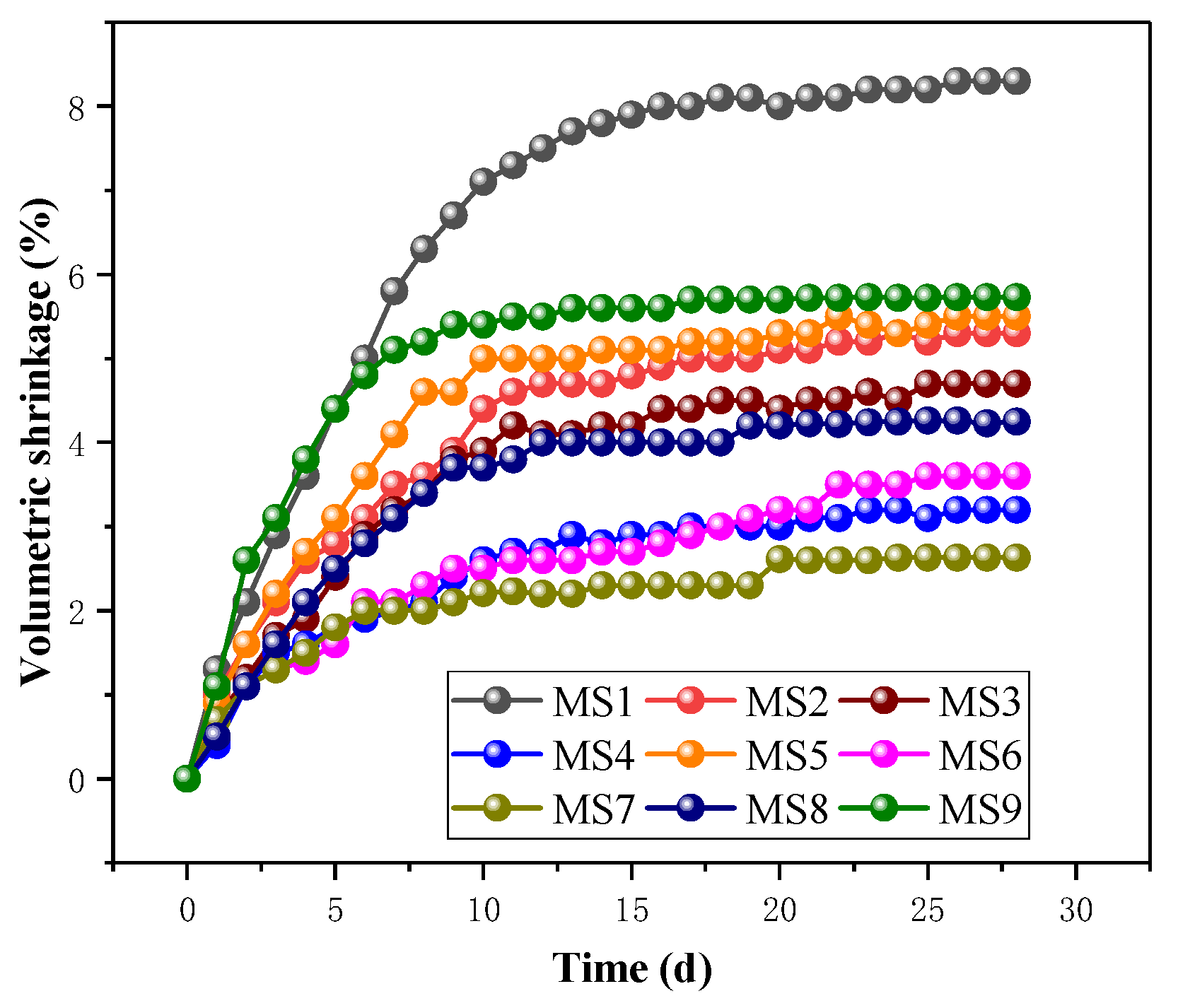

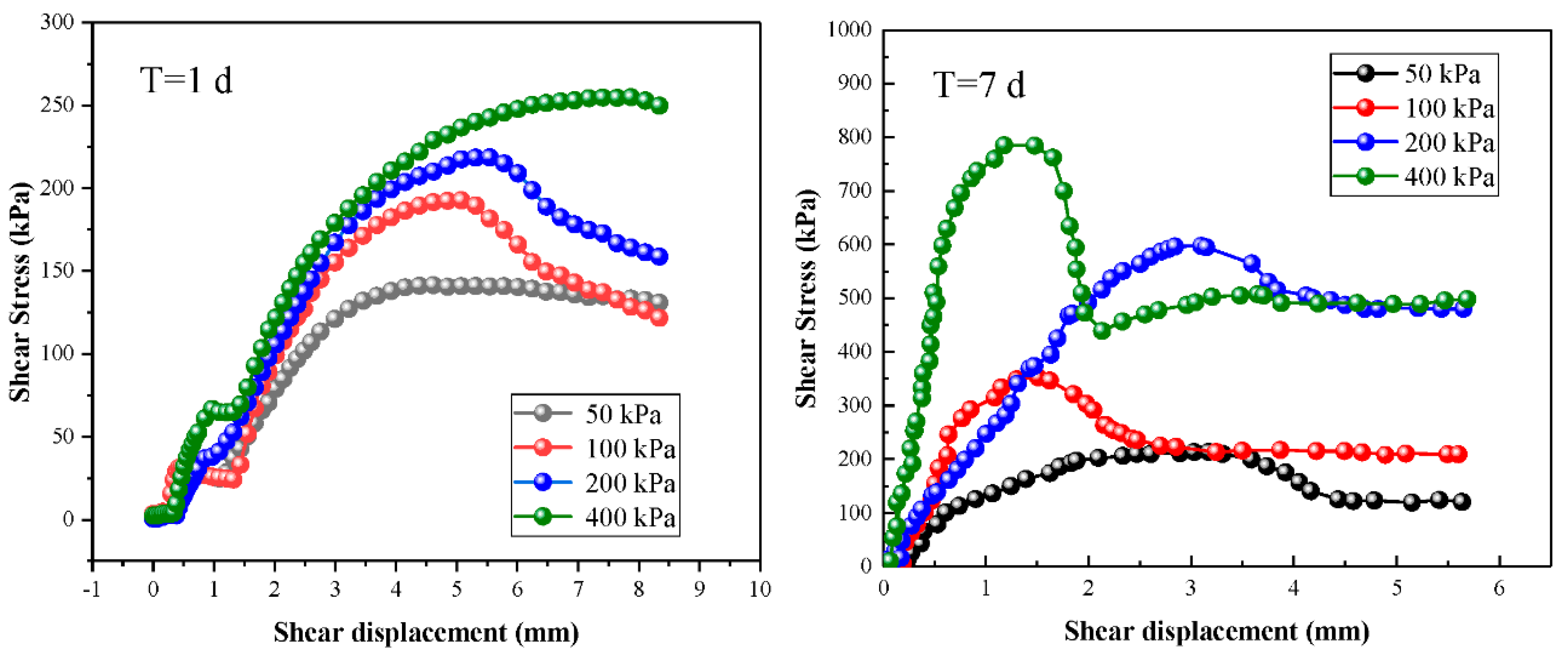

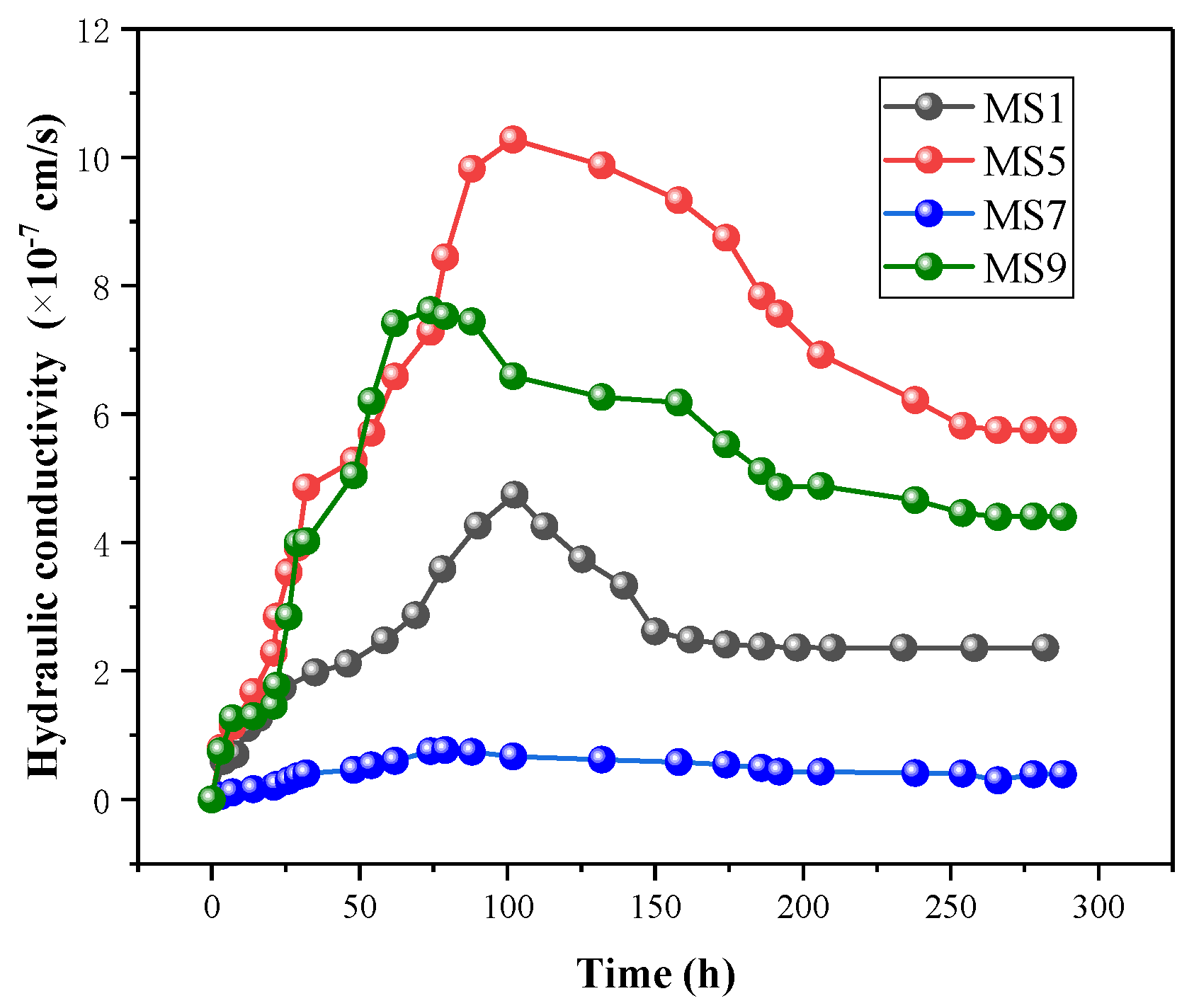


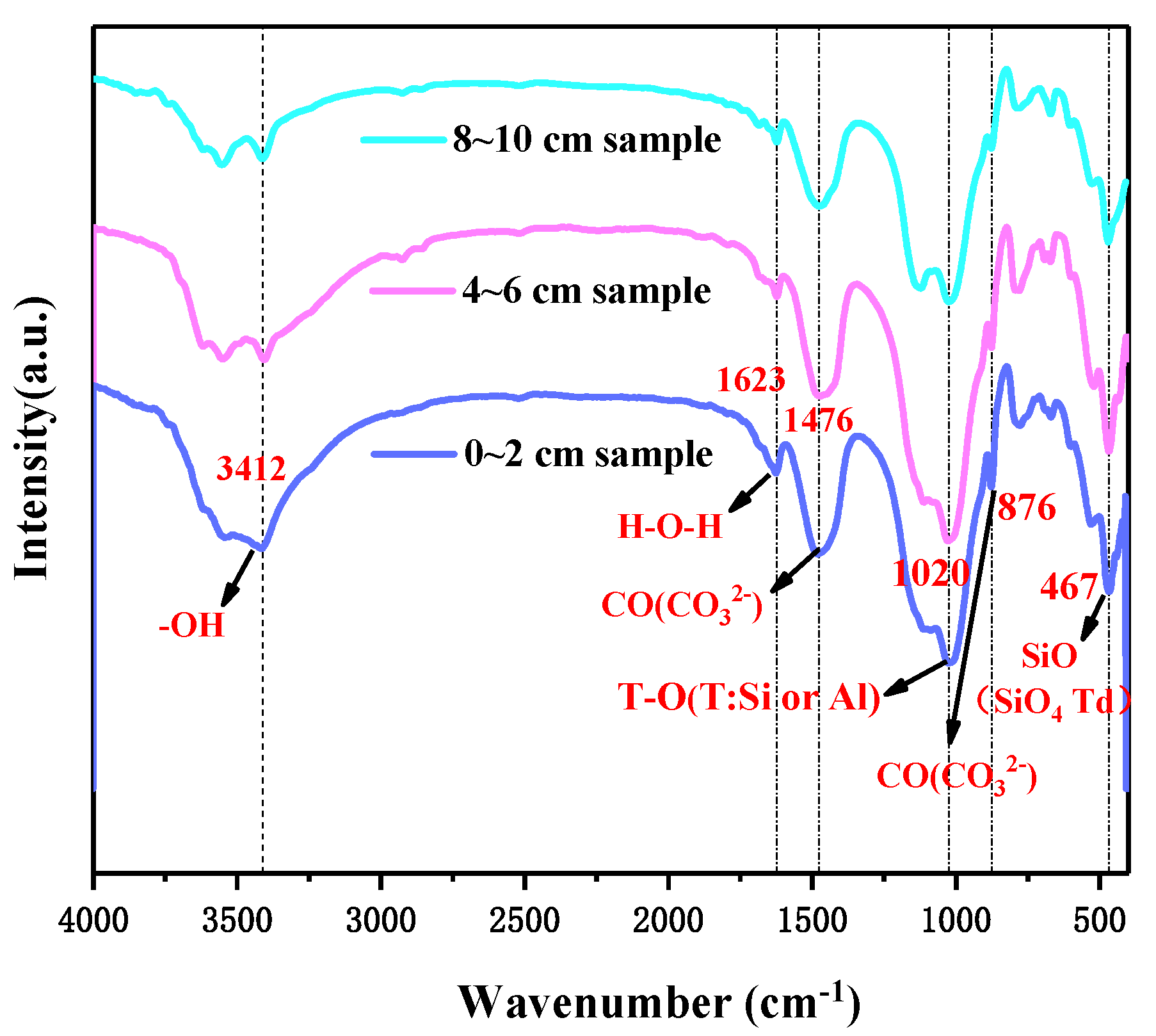
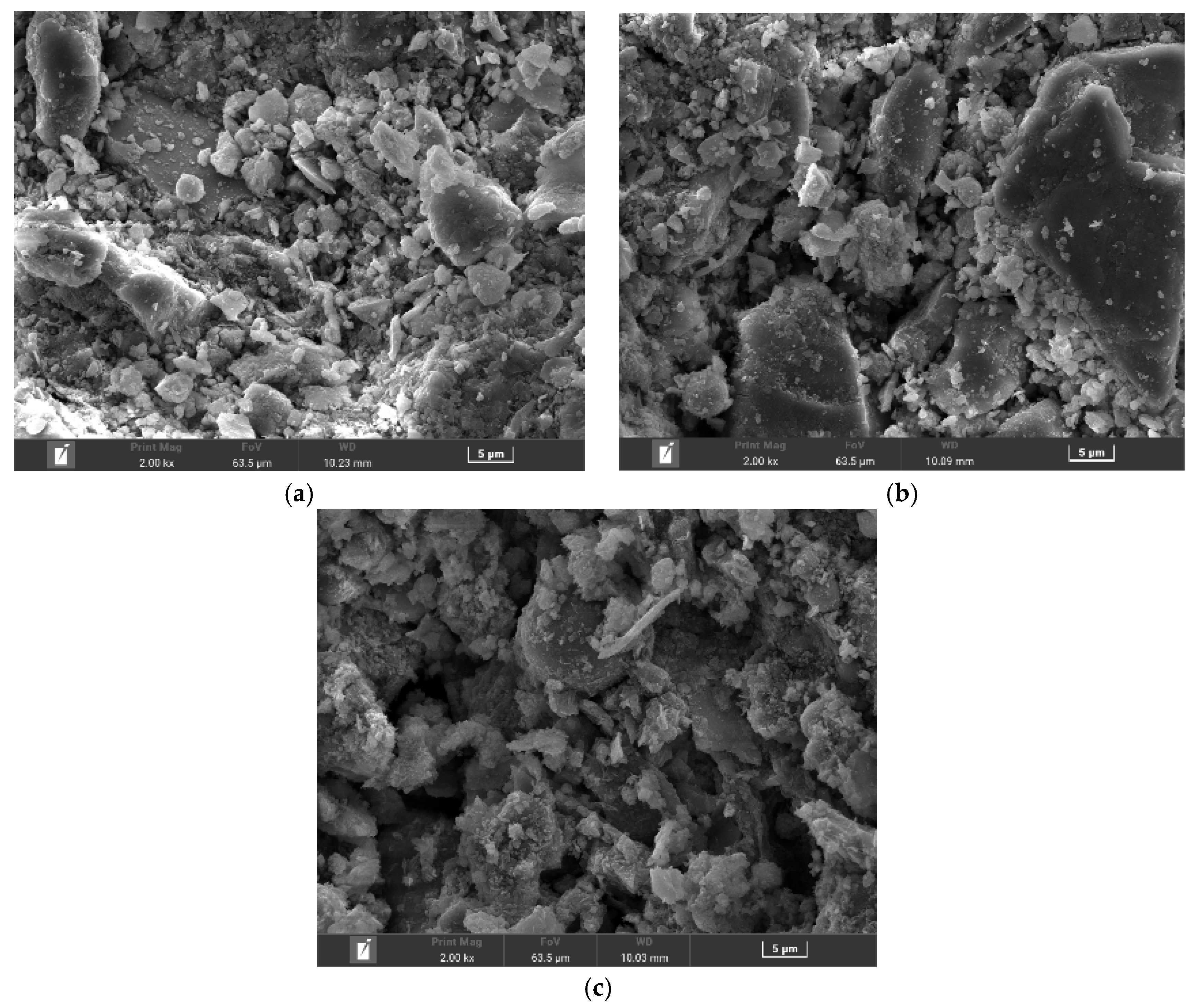
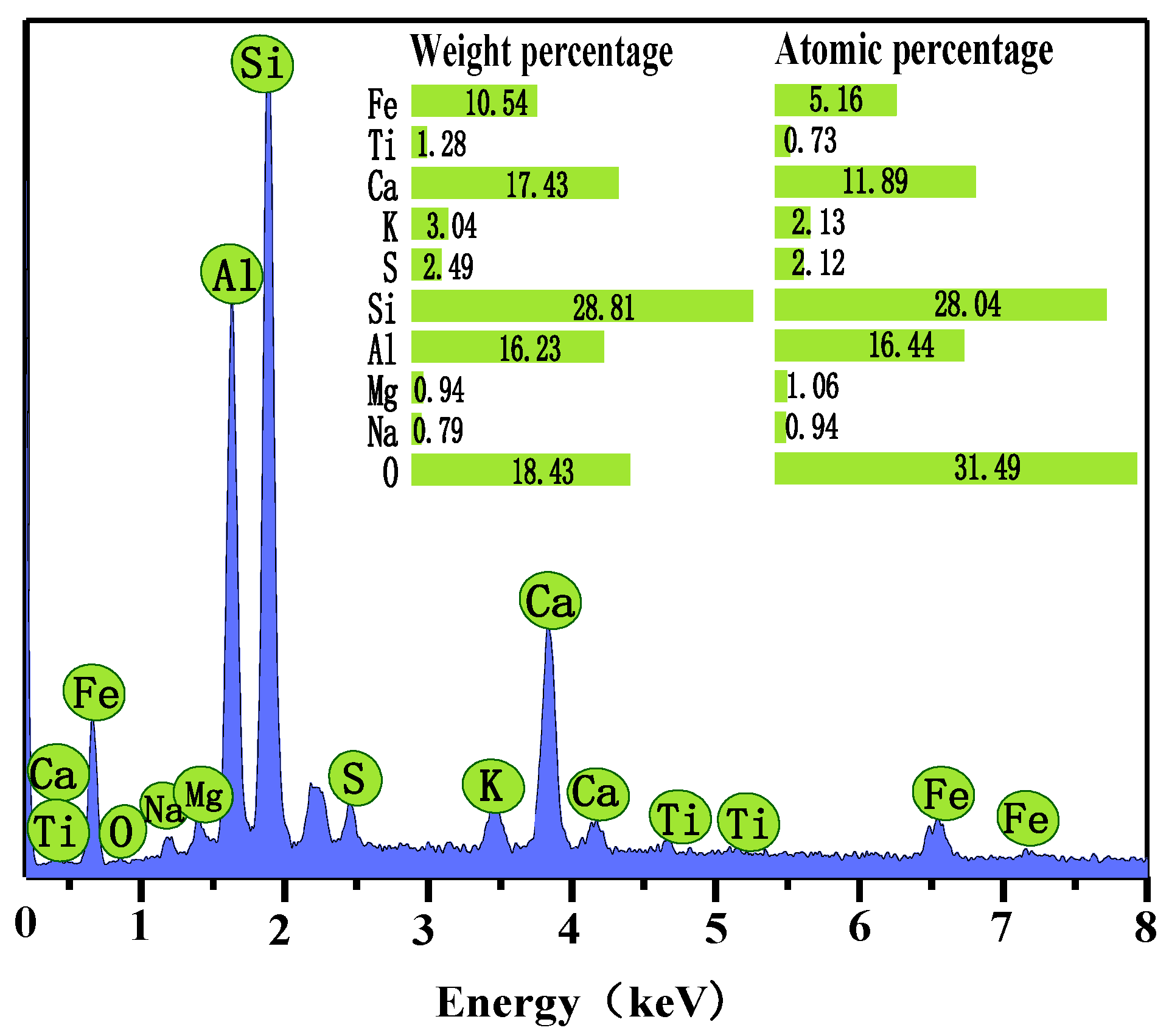
| Name of Raw Material | Main Chemical Composition/% | |||||||
|---|---|---|---|---|---|---|---|---|
| SiO2 | Al2O3 | Fe2O3 | CaO | MgO | K2O | Na2O | Other | |
| Dredged sludge | 56.91 | 18.40 | 9.25 | 6.84 | 2.30 | 0.81 | 0.73 | 4.76 |
| Construction waste powder | 39.77 | 8.81 | 6.28 | 35.11 | 2.09 | 2.28 | 1.13 | 4.53 |
| Desulfuration gypsum | 32.01 | 12.25 | 0.68 | 31.46 | 8.15 | 0.55 | 0.58 | 14.32 |
| Fly ash | 47.28 | 26.85 | 4.89 | 4.52 | 0.33 | 1.42 | 0.78 | 13.93 |
| Superfine slag powder | 29.81 | 13.49 | 1.08 | 36.46 | 6.57 | 0.52 | 0.37 | 11.70 |
| No. | Inner Lake Sludge | Construction Waste Powder | Superfine Slag Powder | Fly Ash | Desulfuration Gypsum |
|---|---|---|---|---|---|
| MS1 | 50% | 20% | 13% | 10% | 7% |
| MS2 | 50% | 22% | 13% | 10% | 5% |
| MS3 | 50% | 26% | 12% | 9% | 3% |
| MS4 | 50% | 22% | 15% | 10% | 3% |
| MS5 | 50% | 22% | 13% | 8% | 7% |
| MS6 | 50% | 22% | 10% | 13% | 5% |
| MS7 | 50% | 22% | 15% | 8% | 5% |
| MS8 | 50% | 22% | 13% | 12% | 3% |
| MS9 | 50% | 22% | 10% | 10% | 8% |
Publisher’s Note: MDPI stays neutral with regard to jurisdictional claims in published maps and institutional affiliations. |
© 2022 by the author. Licensee MDPI, Basel, Switzerland. This article is an open access article distributed under the terms and conditions of the Creative Commons Attribution (CC BY) license (https://creativecommons.org/licenses/by/4.0/).
Share and Cite
Shang, K. Mechanical Characteristics and Micro-Mechanism of Modified Dredged Sludge Based on Calcium-Containing Solid Waste Used as Landfill Cover Materials. Processes 2022, 10, 451. https://doi.org/10.3390/pr10030451
Shang K. Mechanical Characteristics and Micro-Mechanism of Modified Dredged Sludge Based on Calcium-Containing Solid Waste Used as Landfill Cover Materials. Processes. 2022; 10(3):451. https://doi.org/10.3390/pr10030451
Chicago/Turabian StyleShang, Kejian. 2022. "Mechanical Characteristics and Micro-Mechanism of Modified Dredged Sludge Based on Calcium-Containing Solid Waste Used as Landfill Cover Materials" Processes 10, no. 3: 451. https://doi.org/10.3390/pr10030451





